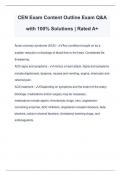CEN Exam Content Outline Exam Q&A with 100% Solutions | Rated A+ Acute coronary syndrome (ACS) - ✔✔Any condition brought on by a sudden re duction or blockage of blood flow to the heart. Considered life threatening. ACS signs and symptoms - ✔✔mimics a heart attack. Signs and symptoms include diaphoresis, dyspnea, nausea and vomiting, angina, chest pain and referred pain. ACS treatment - ✔✔Depending on symptoms and the extent of the artery blockage, medications and/or surgery may be necessary. medications include aspirin, thrombolytic drugs, nitro, angiotensin -
converting enzymes, ACE inhibitors, angiotensin receptor blockers, beta -
blockers, ca lcium channel blockers, cholesterol -lowering drugs, and anticoagulants. When medications do not adequately restore cardiac function, surgical procedures, such as angioplasty and a stent, or coronary bypass surgery, may be necessary. Aneurysm/Dissection - ✔✔An aneurysm is a balloon -like bulge in an artery. Certain medical problems, genetic conditions or trauma can damage arterial walls, and force the blood pushing against these weakened or damaged walls can lead to the formation of an aneurysm. An aneurysm can grow quite large and rupture and/or dissect without any symptomatic warning, thus causing a massive, life -threatening hemorrhage, unless it is immediately diagnosed and treated. A split in one or more of the artery walls, which in known as dissection, causes bleeding into and along the layers of the arterial wall. Ruptures and dissection are often fatal. Aneurysm (abdominal aortic) signs and symptoms - ✔✔Abdominal Aortic Aneurysms tend to develop slowly, but initial symptoms include a throbbing in the abdomen, a deep pain in the back or side of the abdomen, and a steady pain in the abdomen that lasts for hours or days. Once the rupture occurs, symptoms such as nausea, vomiting, constipation, problems urinating, clammy skin, lightheadedness, a rapid pulse and the signs and symptoms of hypovolemic shock occur. Aneurysm (thoracic aortic) signs and symptoms - ✔✔Thoracic aort ic aneurysms may not present symptoms until it dissects or grows large enough to lead to symptoms, such as jaw, neck, back or chest pain, coughing and/or hoarseness, SOB, dyspnea and difficulty swallowing. Sudden, severe, sharp or stabbing pain can start in the back and move to the abdomen, if the aneurysm ruptures or dissects. pain may present in the chest and arms, and then shock can occur quickly. left untreated, organ damage or death can occur. Aneurysm Treatment - ✔✔includes antihypertensive medicatio ns, such as beta blockers or calcium channel blockers, which lower blood pressure and relax blood vessels, both of which can prevent rupture. Another treatment option is surgery. This is usually recommended if the aneurysm is growing quickly or the patie nt is at risk of rupture or dissection. The main types of surgery include open abdominal (or open chest) repair and endovascular repair.




